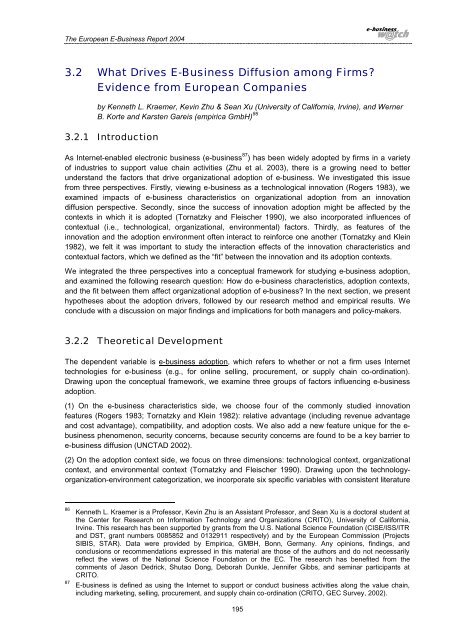The European e-Business Report 2004 - Berlecon Research GmbH
The European e-Business Report 2004 - Berlecon Research GmbH
The European e-Business Report 2004 - Berlecon Research GmbH
Create successful ePaper yourself
Turn your PDF publications into a flip-book with our unique Google optimized e-Paper software.
<strong>The</strong> <strong>European</strong> E-<strong>Business</strong> <strong>Report</strong> <strong>2004</strong>3.2 What Drives E-<strong>Business</strong> Diffusion among Firms?Evidence from <strong>European</strong> Companiesby Kenneth L. Kraemer, Kevin Zhu & Sean Xu (University of California, Irvine), and WernerB. Korte and Karsten Gareis (empirica <strong>GmbH</strong>) 863.2.1 IntroductionAs Internet-enabled electronic business (e-business 87 ) has been widely adopted by firms in a varietyof industries to support value chain activities (Zhu et al. 2003), there is a growing need to betterunderstand the factors that drive organizational adoption of e-business. We investigated this issuefrom three perspectives. Firstly, viewing e-business as a technological innovation (Rogers 1983), weexamined impacts of e-business characteristics on organizational adoption from an innovationdiffusion perspective. Secondly, since the success of innovation adoption might be affected by thecontexts in which it is adopted (Tornatzky and Fleischer 1990), we also incorporated influences ofcontextual (i.e., technological, organizational, environmental) factors. Thirdly, as features of theinnovation and the adoption environment often interact to reinforce one another (Tornatzky and Klein1982), we felt it was important to study the interaction effects of the innovation characteristics andcontextual factors, which we defined as the “fit” between the innovation and its adoption contexts.We integrated the three perspectives into a conceptual framework for studying e-business adoption,and examined the following research question: How do e-business characteristics, adoption contexts,and the fit between them affect organizational adoption of e-business? In the next section, we presenthypotheses about the adoption drivers, followed by our research method and empirical results. Weconclude with a discussion on major findings and implications for both managers and policy-makers.3.2.2 <strong>The</strong>oretical Development<strong>The</strong> dependent variable is e-business adoption, which refers to whether or not a firm uses Internettechnologies for e-business (e.g., for online selling, procurement, or supply chain co-ordination).Drawing upon the conceptual framework, we examine three groups of factors influencing e-businessadoption.(1) On the e-business characteristics side, we choose four of the commonly studied innovationfeatures (Rogers 1983; Tornatzky and Klein 1982): relative advantage (including revenue advantageand cost advantage), compatibility, and adoption costs. We also add a new feature unique for the e-business phenomenon, security concerns, because security concerns are found to be a key barrier toe-business diffusion (UNCTAD 2002).(2) On the adoption context side, we focus on three dimensions: technological context, organizationalcontext, and environmental context (Tornatzky and Fleischer 1990). Drawing upon the technologyorganization-environmentcategorization, we incorporate six specific variables with consistent literature8687Kenneth L. Kraemer is a Professor, Kevin Zhu is an Assistant Professor, and Sean Xu is a doctoral student atthe Center for <strong>Research</strong> on Information Technology and Organizations (CRITO), University of California,Irvine. This research has been supported by grants from the U.S. National Science Foundation (CISE/ISS/ITRand DST, grant numbers 0085852 and 0132911 respectively) and by the <strong>European</strong> Commission (ProjectsSIBIS, STAR). Data were provided by Empirica, GMBH, Bonn, Germany. Any opinions, findings, andconclusions or recommendations expressed in this material are those of the authors and do not necessarilyreflect the views of the National Science Foundation or the EC. <strong>The</strong> research has benefited from thecomments of Jason Dedrick, Shutao Dong, Deborah Dunkle, Jennifer Gibbs, and seminar participants atCRITO.E-business is defined as using the Internet to support or conduct business activities along the value chain,including marketing, selling, procurement, and supply chain co-ordination (CRITO, GEC Survey, 2002).195
















